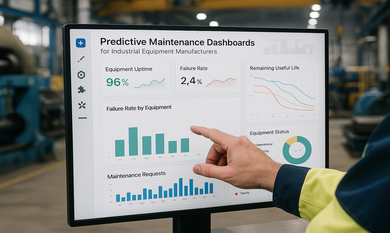In today’s fast-moving logistics industry, efficiency is everything. The ability to deliver goods faster, safer, and at lower costs determines a business’s competitiveness. As consumer expectations for same-day deliveries and real-time updates grow, companies are increasingly adopting fleet optimization web apps to streamline operations and improve decision-making.
Web-based fleet management and route optimization systems empower logistics firms to track vehicles, manage deliveries, and analyze performance in real-time. With the right web app, companies can predict challenges, reduce idle time, optimize driver routes, and minimize fuel expenses — all from a single dashboard.
Let’s explore how real-time fleet and route optimization web apps are transforming modern transportation and logistics management.
Understanding Real-Time Fleet and Route Optimization
Fleet and route optimization involves planning and managing vehicle movements to ensure maximum productivity and minimum operational cost. Traditionally, logistics teams relied on manual scheduling or static route plans, which often failed to consider changing factors such as traffic, weather, or last-minute order updates.
Real-time route tracking through web apps eliminates these inefficiencies. By integrating live GPS data, AI algorithms, and cloud-based analytics, companies can dynamically adjust routes, monitor driver behavior, and ensure timely deliveries.
Modern transport management applications are not just about navigation — they act as intelligent systems that process real-time data to improve logistics decisions continuously.
The Growing Demand for Web Apps in Fleet Management
The shift to web-based solutions has gained significant traction because of accessibility, scalability, and compatibility across devices. Unlike standalone desktop software, web apps can be accessed anywhere, anytime — making them ideal for fleet managers, drivers, and clients who need real-time updates on deliveries.
With custom web app development services Dallas, companies can create tailored solutions that address unique challenges such as managing mixed vehicle fleets, scheduling multi-stop deliveries, or ensuring compliance with local transport regulations.
Moreover, the rise of AI-based transport routing allows web apps to predict bottlenecks, recommend efficient routes, and even forecast vehicle maintenance needs. This level of automation is revolutionizing the logistics sector.
Key Features of Real-Time Fleet and Route Optimization Web Apps
1. Dynamic Fleet Monitoring
Web apps enable dynamic fleet monitoring, offering real-time visibility into every vehicle’s status, location, and route progress. Managers can monitor performance metrics such as average speed, idle time, and delivery success rates through visual dashboards.
For example, UPS uses advanced web-based route optimization software that helps drivers deliver millions of packages daily. This platform reduces unnecessary miles and cuts fuel costs significantly.
2. Real-Time Delivery Tracking
Customers today expect transparency and instant updates. Real-time delivery tracking allows them to view where their shipment is at any given moment, enhancing trust and satisfaction.
For logistics providers, this means fewer customer inquiries and improved operational transparency. Web apps make it easy to integrate live map tracking and push notifications that update clients automatically as deliveries progress.
3. AI-Powered Route Optimization
With AI-based transport routing, web apps analyze multiple factors such as delivery deadlines, driver performance, vehicle capacity, and weather conditions to suggest the most efficient routes.
A good example is DHL, which uses AI-driven logistics software development to optimize its delivery routes across multiple geographies, helping reduce emissions and improve customer experience.
4. Predictive Maintenance and Vehicle Health Monitoring
Modern fleet web apps can predict potential vehicle failures before they happen. Using IoT sensors and AI analytics, they analyze fuel efficiency, tire pressure, and engine health, allowing proactive maintenance scheduling.
This predictive approach reduces downtime, prevents costly repairs, and extends fleet lifespan.
5. Seamless Communication and Reporting
Transport optimization platforms often include built-in chat and alert systems that keep drivers and managers connected at all times. Automated reports help evaluate performance metrics and identify areas for improvement.
These reports can be customized for different stakeholders, from operations managers to clients, enabling better transparency and accountability.
How Web Apps Improve Operational Efficiency
A well-developed fleet optimization web app does much more than track vehicles. It transforms how logistics operations are managed:
- Reduces fuel costs by planning the most efficient routes.
- Enhances safety through driver behavior monitoring and alerts.
- Boosts productivity by automating scheduling and reporting tasks.
- Improves customer experience with live tracking and accurate ETAs.
- Minimizes downtime with predictive maintenance.
By leveraging web-based solutions, companies can monitor hundreds of vehicles across cities or even countries without depending on manual data collection.
Real-World Example: Amazon’s Smart Logistics Ecosystem
Amazon is one of the best examples of a company using web-based route optimization to manage complex logistics operations. Through its in-house logistics software development, Amazon uses machine learning and real-time analytics to assign delivery routes based on distance, traffic patterns, and customer preferences.
The system helps drivers deliver thousands of packages daily while optimizing fuel efficiency and ensuring punctual deliveries. Similar solutions are now being developed for smaller logistics firms using cost-effective web technologies.
Integrating Mobile Technology for Field Operations
To further streamline operations, logistics companies often combine web apps with mobile solutions. Drivers can access updates, route changes, and customer details directly from their smartphones or tablets.
Partnering with the best android app development company Dallas allows logistics firms to extend web app functionality to Android-based mobile devices. This ensures seamless communication between field staff and management, even in remote areas.
For instance, a driver can receive a route update through the mobile app while the central web system automatically adjusts delivery schedules for others in the fleet.
Technology Stack for Developing Fleet Optimization Web Apps
Developing robust fleet and route optimization web apps involves integrating several advanced technologies:
- Front-end: React.js or Angular for an intuitive interface.
- Back-end: Node.js or Python for scalable and high-speed processing.
- Database: MongoDB or PostgreSQL for storing real-time data.
- Cloud Services: AWS, Google Cloud, or Azure for scalability.
- APIs and IoT Integration: For connecting GPS devices, sensors, and maps.
- AI and Machine Learning: For predictive analytics and route optimization.
By choosing a flexible stack, developers can ensure the web app adapts to business growth and evolving market needs.
Benefits of Real-Time Fleet and Route Optimization for Businesses
1. Reduced Operational Costs
Optimized routes minimize unnecessary travel, leading to lower fuel consumption and vehicle wear.
2. Improved Delivery Accuracy
Real-time route tracking ensures on-time deliveries and immediate responses to unexpected delays.
3. Enhanced Decision-Making
Data collected from fleet movements helps managers make informed decisions about vehicle usage and resource allocation.
4. Sustainability Goals
Efficient routing reduces carbon emissions, supporting eco-friendly logistics strategies.
5. Scalable Growth
Cloud-based systems allow logistics companies to scale operations quickly without adding infrastructure costs.
The Role of AI and IoT in Transport Optimization
AI and IoT are at the heart of next-gen logistics route web apps. AI algorithms analyze route patterns and traffic data to recommend optimal paths, while IoT sensors monitor real-time vehicle metrics such as fuel levels and temperature.
These insights help companies achieve real-time delivery tracking and efficient machine learning in production, ensuring that resources are used effectively. The integration of smart factory maintenance and predictive systems further extends these technologies beyond logistics into connected manufacturing ecosystems.
Conclusion
Web apps have become essential tools for logistics companies striving for operational efficiency, real-time insights, and competitive advantage. With technologies like AI, IoT, and cloud computing, fleet and route optimization is evolving into a highly data-driven and customer-centric process.
Theta Technolabs, a leading node js web development company Dallas, specializes in creating intelligent, scalable, and secure web solutions that optimize transportation workflows. Backed by expertise in Web, Mobile, and Cloud, the firm empowers logistics businesses to achieve smarter fleet management and efficient route planning.
Ready to Optimize Your Fleet Operations?
Enhance your logistics performance with a custom-built web app tailored to your business goals. 📩 Contact us at sales@thetatechnolabs.com for a consultation today.






















_Choosing%20the%20Right%20App%20Development%20Company_%20A%20Comprehensive%20Guide_Q1_24.jpg)
_Chatbots%20for%20Event%20Management%20and%20Hospitality%20Services_Q1_24.jpg)
_Best%20iOS%20App%20Development%20Company_%20Enhancing%20User%20Engagement%20with%20Push%20Notifications_Q2_24.jpg)
_Key%20Trends%20in%20Healthcare%20Software%20Development%20for%20the%20Future_Q2_24.jpg)
_How%20much%20does%20it%20cost%20to%20create%20an%20android%20app%20in%202024%20for%20Startups_%20A%20detailed%20guide_Q2_24.jpg)
_Integrating%20Chatbots%20Into%20Your%20Application.jpg)


_Enhancing%20Driver%20Safety%20and%20Compliance%20with%20Web%20Apps%20in%20the%20Logistics%20Sector_Q3_24.jpg)
_Web%20Apps%20for%20Retail%20and%20eCommerce_%20Streamlining%20Operations%20and%20Reducing%20Costs_Q3_24.jpg)
_How%20AI%20is%20Enhancing%20Construction%20Site%20Surveillance%20and%20Security%20in%20Dallas_Q3_24-1.jpg)
_The%20Impact%20of%20Cross-Platform%20Apps%20on%20Real%20Estate%20Market%20Trends%20in%20Dallas_Q3_24-1.jpg)
_Streamlining%20Appointment%20Scheduling%20with%20Cloud%20Computing%20in%20Dallas%20Healthcare_Q4_25.jpg)
_How%20Cloud%20Solutions%20Are%20Enhancing%20Remote%20Patient%20Monitoring%20in%20Healthcare_Q4_25.jpg)































.png)












.png)

.png)
.png)
.png)
.png)


.png)
.png)
.png)

.png)






.png)
.png)























